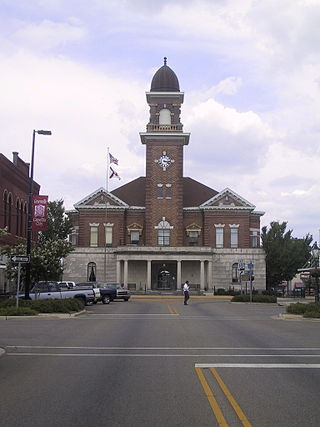
Greenville is a city and the county seat of Butler County, Alabama, United States. At the 2020 census, the population was 7,374. Greenville is known as the Camellia City, wherein originated the movement to change the official Alabama state flower from the goldenrod to the camellia with legislative sponsors LaMont Glass and H.B. Taylor.

Wetumpka is a city in and the county seat of Elmore County, Alabama, United States. At the 2020 census, the population was 7,220. In the early 21st century Elmore County became one of the fastest-growing counties in the state. The city is considered part of the Montgomery Metropolitan Area.

Greenville is an incorporated town in Floyd County, Indiana. The population was 595 at the 2010 census. Greenville is located in the greater Louisville metropolitan area.

Fountain Inn is a city in Greenville and Laurens counties in the U.S. state of South Carolina. The population was 10,416 at the 2020 census, up from 7,799 in 2010. It is part of the Greenville-Mauldin-Easley Metropolitan Statistical Area.

The Chamber of Commerce Building is a commercial building on 65 Liberty Street, between Liberty Place and Broadway, in the Financial District of Manhattan in New York City. Designed by architect James Barnes Baker, the four-story Beaux-Arts building was constructed between 1901 and 1902 as the first headquarters to be built specifically for the Chamber of Commerce of the State of New York.

Demopolis Town Square, currently officially known as Confederate Park, is a historic park in the city of Demopolis, Alabama, United States. It is one of the oldest public squares in the state. Demopolis had its beginnings in 1817 with the Vine and Olive Colony, and the park was established in 1819. The park covers one city block, bounded by Main, Capitol, Walnut, and Washington Streets.

Trinity Episcopal Church is a historic church in Mobile, Alabama, United States. It was the first large Gothic Revival church built in Alabama. The building was designed by architects Frank Wills and Henry Dudley.

The Raphael Semmes House, also known as the Horta–Semmes House, is a historic residence in Mobile, Alabama. It is best known for having been the home of Admiral Raphael Semmes, captain of the Confederate sloop-of-war CSS Alabama. The house was added to the National Register of Historic Places on February 26, 1970.
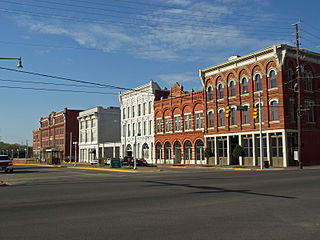
The Lower Commerce Street Historic District is a 45-acre (18 ha) historic district in the old commercial district of Montgomery, Alabama. It includes fifty-two contributing buildings. It is roughly bounded by the Central of Georgia railroad tracks, North Lawrence Street, Madison Avenue, and Commerce Street. Architectural styles in the district include the Italianate, Classical Revival, and Renaissance Revival. It was placed on the National Register of Historic Places on March 29, 1979, the boundaries were subsequently increased on February 25, 1982, and January 15, 1987.
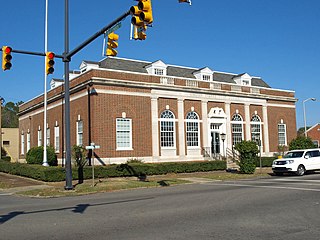
The Post Office Historic District is a historic district in Greenville, Alabama at 100–115 West Commerce and 101 East Commerce Streets. It was listed on the National Register of Historic Places in 1986 and includes Early Commercial architecture, Classical Revival architecture, and Art Deco architecture in its nine contributing buildings.

The Blandford Church is the oldest building in Petersburg, Virginia whose history is well documented. It is at the highest point in the city, atop Well's Hill. It is today (2019) part of a memorial to Southern soldiers who died during the Civil War. It is adjacent to Blandford Cemetery, one of the oldest, largest and historically significant cemeteries in Virginia. The Blandford Cemetery did not exist until after the church building had been abandoned, in the early 1800s, and the land purchased by the city to use as a cemetery.

Butler Chapel A.M.E. Zion Church is a historic African Methodist Episcopal Zion Church built in 1913, and located in Greenville, Alabama. It was one of three significant meeting places for African-Americans living in Greenville during the early-20th century.
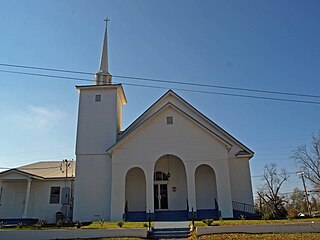
First Baptist Church is a historic Baptist church at 707 South Street in Greenville, Alabama. It was founded and built in 1870 by Rev. Stuart Adams and added to the National Register of Historic Places in 1986.
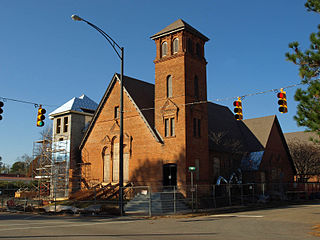
First Presbyterian Church is a historic Presbyterian church at 215 East Commerce Street in Greenville, Alabama. It was built in 1886 and added to the National Register of Historic Places in 1986. The church is a member of the Presbyterian Church in America.

Greenville City Hall in Greenville, Alabama is a historic city hall. The building was designed by Montgomery architect Moreland Griffith Smith, and built in 1936–37 by workers from the Works Progress Administration. The building is designed in a Colonial Revival style with Palladian influences, a popular style in the 1930s due to the recent restoration of Colonial Williamsburg. It was built on the site of a grammar school that was originally built in the 1890s, but burned in the early 1920s and again in 1927. The building is constructed of brick, with a full-height portico around the main entry. Each window on the first floor is topped with an ashlar keystone. The corners of the main block are adorned with stone quoins. The building was listed on the National Register of Historic Places in 1986.

The Commerce Street Residential Historic District is a historic district in Greenville, Alabama. The district consists of four houses along Commerce Street, constructed between 1846 and 1895. They represent the final and last remaining residential construction on the town's main street.

The East Commerce Street Historic District is a historic district in Greenville, Alabama. The district contains Greenville's oldest commercial buildings, as well as the Butler County Courthouse. The first courthouse on the site was built in 1822; the current, fourth, courthouse was completed in 1903. The commercial buildings date from the 1880s through 1928 and are primarily vernacular brick structures. A fire in 1927 destroyed many buildings along Commerce Street. A National Guard Armory was built south of the courthouse, on Conecuh Street, by the Works Progress Administration in 1936.
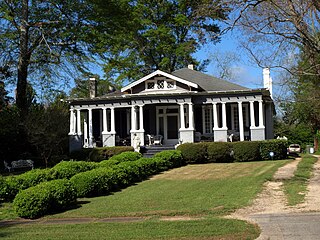
The Fort Dale-College Street Historic District is a historic district in Greenville, Alabama. The district contains Greenville's oldest existing affluent residences, dating to as early as the 1850s. In the initial federal land sale following the Creek War, the area that became northwest Greenville was claimed by William Dunklin. Dunklin sold the claim to William Burnette, who began to parcel the land for sale and to give to family members. Burnette's daughter and son-in-law built a Corinthian-columned Greek Revival home in 1857. A few other pre-Civil War houses remain, and construction continued after the war, including a school building that was later converted into a house. Most of the early residences were large, and built in Greek Revival, Second Empire, and Colonial Revival styles. Beginning in the 20th century, bungalows and cottages on smaller lots began to emerge. One of the later constructions in the district is a Spanish Colonial Revival house, built in 1928.






















